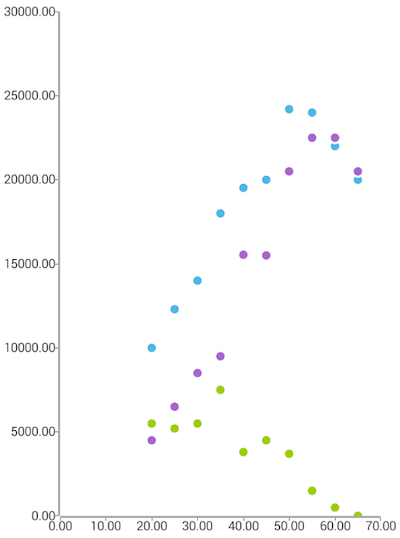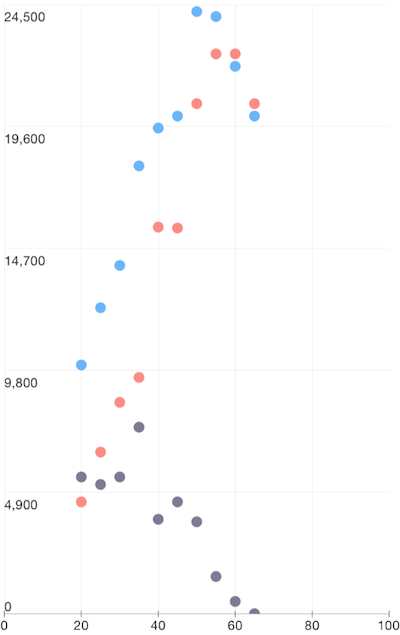Chart Scatter Series
ScatterSeries are a type of CartesianSeries that use Cartesian coordinates to display values for typically two variables for a set of data. The data are displayed as a collection of points, each having the value of one variable determining the position on the horizontal axis and the value of the other variable determining the position on the vertical axis.
Setup
To display a Scatter Chart, you will need to: To display a Scatter Bubble Chart, you will need to:
- Add a RadCartesianChart to your page.
- Set the chart's horizontalAxis to a category axis (CategoricalAxis, DateTimeCategoricalAxis or DateTimeContinuousAxis).
- Set the chart's verticalAxis to a value axis (LinearAxis or LogarithmicAxis).
- Add at least one instance of ScatterSeries to the chart's series property and set its items property to a collection of data items and the xProperty and yProperty to the names of the properties used to determine where to plot the scatter points.
To illustrate this setup, let's create an example. First we will create a source with items:
Example 1: Define a source with data
get scatterSource() {
return [
{ Age: 20, Salary: 10000, Spendings: 4500, Savings: 5500, Impact: 1 },
{ Age: 25, Salary: 12300, Spendings: 6500, Savings: 5200 , Impact: 7},
{ Age: 30, Salary: 14000, Spendings: 8500, Savings: 5500 , Impact: 10},
{ Age: 35, Salary: 18000, Spendings: 9500, Savings: 7500 , Impact: 6},
{ Age: 40, Salary: 19520, Spendings: 15540, Savings: 3800 , Impact: 4},
{ Age: 45, Salary: 20000, Spendings: 15500, Savings: 4500 , Impact: 2},
{ Age: 50, Salary: 24200, Spendings: 20500, Savings: 3700 , Impact: 11},
{ Age: 55, Salary: 24000, Spendings: 22500, Savings: 1500 , Impact: 8},
{ Age: 60, Salary: 22000, Spendings: 22500, Savings: 500 , Impact: 1},
{ Age: 65, Salary: 20000, Spendings: 20500, Savings: 10, Impact: 9 }
];
}
We use an instance of this model to assign it as the bindingContext of the page we have put our Scatter series on:
Example 2: Update bindingContext
import { ScatterDataModel } from "../../data-models/scatter-data-model";
export function onPageLoaded(args) {
const page = args.object;
page.bindingContext = new ScatterDataModel();
}
And finally, in the XML definition of the page we put a RadCartesianChart, add a ScatterSeries instance to it and bind the series to the source of data:
Example 3: Add chart to page's markup
<chart:RadCartesianChart>
<chart:RadCartesianChart.horizontalAxis>
<chart:LinearAxis/>
</chart:RadCartesianChart.horizontalAxis>
<chart:RadCartesianChart.verticalAxis>
<chart:LinearAxis/>
</chart:RadCartesianChart.verticalAxis>
<chart:RadCartesianChart.series>
<chart:ScatterSeries items="{{ scatterSource }}" xProperty="Age" yProperty="Salary"/>
<chart:ScatterSeries items="{{ scatterSource }}" xProperty="Age" yProperty="Spendings"/>
<chart:ScatterSeries items="{{ scatterSource }}" xProperty="Age" yProperty="Savings"/>
</chart:RadCartesianChart.series>
</chart:RadCartesianChart>
Figure 1: Chart with ScatterSeries on Android (left) and iOS (right)


References
Want to see this scenario in action? Check our SDK examples repo on GitHub. You will find this and many other practical examples with NativeScript UI.
Examples used in this article:
Related articles you might find useful: